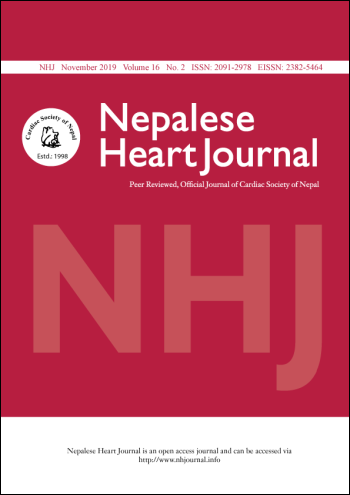Study of clinical profile and outcomes of Percutaneous Coronary Intervention in ST Elevation Myocardial Infraction
DOI:
https://doi.org/10.3126/njh.v16i2.26318Keywords:
Coronary Artery Disease, Percutaneous Intervention, ST elevation Myocardial infarctionAbstract
Background and Aims: Percutaneous Coronary Intervention (PCI) is the preferred method of revascularization in Acute ST Elevation Myocardial Infarction (STEMI). Our aim was to study the clinical profile and outcomes of patients who underwent PCI for STEMI at tertiary cardiac centre of Nepal.
Methods: It is a retrospective, single centre study, performed at Tribhuvan University, Manmohan Cardiothoracic Vascular and Transplant Centre, Kathmandu, Nepal. All patients who underwent PCI for STEMI from November 2015 to July 2018 were enrolled in this study. All the data were collected from hospital registry and cath lab records.
Results: The Study showed that out of 232 patients who presented with STEMI, 74.5% were male with average age of 57.39 years. The mean time of presentation after onset of symptom/s was 17.5 hours. About 66% patients presented in less than 12 hours of symptoms onset, 21% presented at 12-24 hours of symptoms onset and 13% patients presented late. Primary PCI was done in 87% of patients. Almost all patients (98.2%) underwent coronary artery stenting with drug eluting stents. Multivessel PCI during index procedure was done in 7 patients. TIMI III flow following PCI was achieved in 97% cases. Average LVEF at discharge was 44.73%. There were 8 deaths, all after Primary PCI. In-hospital mortality rates for patients presenting with and without cardiogenic shock were 38.46% and 1.59% respectively. The overall mortality rate was 3.98%.
Conclusion: This study has reemphasized that PCI is effective in the management of STEMI cases in Nepal with improving mortality rates and decreasing complications. Minimizing the delayed presentation after the onset of symptoms should be one of the prime focuses for effective management of STEMI.
Downloads
Downloads
Published
How to Cite
Issue
Section
License
This license enables reusers to distribute, remix, adapt, and build upon the material in any medium or format, so long as attribution is given to the creator. The license allows for commercial use.




